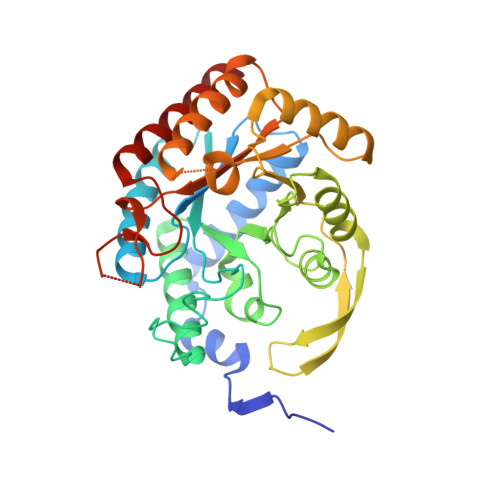An Inhibitor-in-Pieces Approach to DAHP Synthase Inhibition: Potent Enzyme and Bacterial Growth Inhibition.
Heimhalt, M., Mukherjee, P., Grainger, R.A., Szabla, R., Brown, C., Turner, R., Junop, M.S., Berti, P.J.(2021) ACS Infect Dis 7: 3292-3302
- PubMed: 34761906
- DOI: https://doi.org/10.1021/acsinfecdis.1c00462
- Primary Citation of Related Structures:
7RUD, 7RUE - PubMed Abstract:
3-Deoxy-d- arabino heptulosonate-7-phosphate (DAHP) synthase catalyzes the first step in the shikimate biosynthetic pathway and is an antimicrobial target. We used an inhibitor-in-pieces approach, based on the previously reported inhibitor DAHP oxime, to screen inhibitor fragments in the presence and absence of glycerol 3-phosphate to occupy the distal end of the active site. This led to DAHP hydrazone, the most potent inhibitor to date, K i = 10 ± 1 nM. Three trifluoropyruvate (TFP)-based inhibitor fragments were efficient inhibitors with ligand efficiencies of up to 0.7 kcal mol -1 /atom compared with 0.2 kcal mol -1 /atom for a typical good inhibitor. The crystal structures showed the TFP-based inhibitors binding upside down in the active site relative to DAHP oxime, providing new avenues for inhibitor development. The ethyl esters of TFP oxime and TFP semicarbazone prevented E. coli growth in culture with IC 50 = 0.21 ± 0.01 and 0.77 ± 0.08 mg mL -1 , respectively. Overexpressing DAHP synthase relieved growth inhibition, demonstrating that DAHP synthase was the target. Growth inhibition occurred in media containing aromatic amino acids, suggesting that growth inhibition was due to depletion of some other product(s) of the shikimate pathway, possibly folate.
- Department of Biochemistry, Molecular Biology Lab, Western University, London, Ontario N6A 5C1, Canada.
Organizational Affiliation:


















